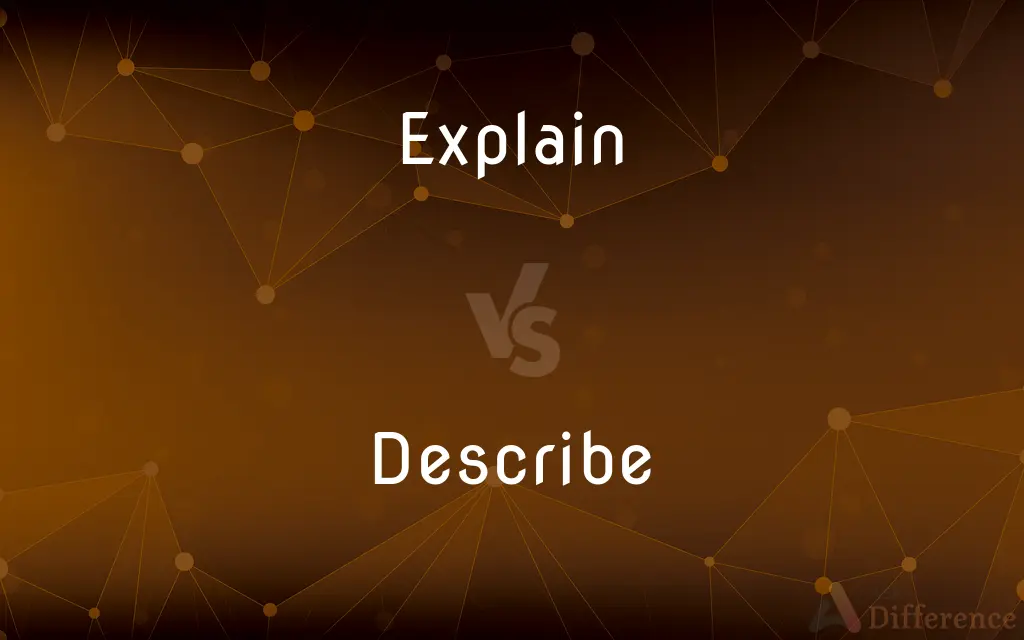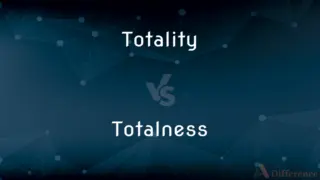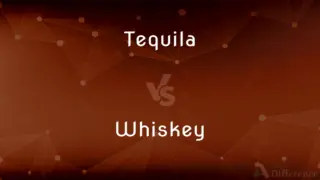Explain vs. Describe — What's the Difference?
Edited by Tayyaba Rehman — By Fiza Rafique — Updated on March 16, 2024
Explaining involves clarifying how and why something happens, focusing on reasons and mechanisms, while describing involves detailing what something is like, focusing on characteristics and observations.

Difference Between Explain and Describe
Table of Contents
ADVERTISEMENT
Key Differences
To explain something means to make its workings or reasons clear. It involves breaking down concepts into simpler parts, providing causes, effects, and processes. For example, explaining the water cycle involves discussing the mechanisms of evaporation, condensation, and precipitation, and why they occur. On the other hand, to describe something is to depict or detail its features, aspects, or appearance without necessarily delving into the underlying reasons or mechanisms. Describing the water cycle would involve stating observations about rain, clouds, and water flow on the Earth's surface.
Explaining often requires a deeper understanding of a subject because it involves linking facts to theories, principles, or laws to clarify how something works or why something happens. It's about connecting the dots between knowledge and observation. In contrast, describing can be done with surface-level knowledge, focusing on what is observable or known without needing to understand the underlying principles.
In educational contexts, explaining helps students grasp the underlying principles of a concept, aiding in problem-solving and critical thinking. It encourages asking "Why?" or "How?" leading to a more profound comprehension. Whereas, describing often serves as a foundational step, helping students familiarize themselves with the terminology, processes, or systems by addressing "What?" or "Which?" aspects.
In scientific writing, explanations are crucial for understanding the mechanisms behind phenomena, results, or theories. They provide a basis for hypotheses, interpretation of data, and the rationale for experiments. Descriptions, however, are essential for accurately conveying observations, experimental setups, or characteristics of study subjects, allowing readers to visualize or comprehend the specific details being discussed.
When explaining, one might use cause-and-effect language, logical reasoning, and theoretical frameworks. This approach aims to illuminate the reader or listener on the subject's deeper aspects. In describing, sensory details, objective descriptions, and straightforward observations are more common, aiming to create a clear picture or detailed account of the subject without necessarily providing a deeper understanding.
ADVERTISEMENT
Comparison Chart
Focus
How and why things happen
What something is like
Required Knowledge
Deep understanding of concepts, causes, and mechanisms
Surface-level knowledge of characteristics and observations
Language Used
Cause-and-effect, logical reasoning
Sensory details, objective descriptions
Purpose
To clarify mechanisms, reasons, and processes
To depict features, aspects, or appearance
Outcome
Deeper comprehension and connection between concepts
Familiarization with subject without deep understanding
Examples
Explaining the process of photosynthesis
Describing the appearance of a plant
Educational Role
Aids in problem-solving and critical thinking
Serves as foundational knowledge
Scientific Role
Understanding mechanisms, interpreting data, justifying theories
Conveying observations, detailing experimental setups
Compare with Definitions
Explain
Making clear the reasons or processes behind something.
Explaining why the sky is blue involves discussing light scattering.
Describe
Does not require deep understanding.
Describing how to use an app involves steps and features, not software engineering concepts.
Explain
Relies on connecting facts to theories.
Explaining a medical symptom involves linking it to underlying conditions.
Describe
Aids in creating a clear picture or account.
Describing a novel's setting involves detailing the time period and location.
Explain
Involves detailing how something works.
Explaining a car's transmission system requires knowledge of mechanics.
Describe
Involves what is observable or known.
Describing a chemical compound includes its structure, color, and properties.
Explain
Aims at deeper understanding.
Explaining economic theories involves analyzing their principles and impacts.
Describe
Focused on characteristics without underlying reasons.
Describing a historical event involves stating who, what, when, and where.
Explain
Provides the cause-and-effect relationship.
Explaining climate change includes discussing greenhouse gases' effects.
Describe
Detailing the features or appearance of something.
Describing a sunset involves colors, the landscape, and the atmosphere.
Explain
Make (an idea or situation) clear to someone by describing it in more detail or revealing relevant facts
He explained the situation
‘It's a device of great age,’ the professor explained
They explained that their lives centred on the religious rituals
Describe
To give an account of in speech or writing
Describe a sea voyage.
Explain
To make plain or comprehensible.
Describe
To convey an idea or impression of; characterize
She described her childhood as a time of wonder and discovery.
Explain
To define; expound
We explained our plan to the committee.
Describe
To represent pictorially; depict
Goya's etchings describe the horrors of war in grotesque detail.
Explain
To offer reasons for or a cause of; justify
Explain an error.
Describe
To trace the form or outline of
Describe a circle with a compass.
Explain
To offer reasons for the actions, beliefs, or remarks of (oneself).
Describe
(transitive) To represent in words.
The feeling is difficult to describe, but not unpleasant.
The geographer describes countries and cities.
Several witnesses describe seeing lights in the sky that night.
Explain
To make something plain or comprehensible
Let me explain.
Describe
(transitive) To represent by drawing; to draw a plan of; to delineate; to trace or mark out.
To describe a circle by the compasses;
A torch waved about the head in such a way as to describe a circle
Explain
To make plain, manifest, or intelligible; to clear of obscurity; to illustrate the meaning of.
She is about to explain a chapter of the Bible to the Sunday School students.
She tried to explain but he wouldn’t listen.
Describe
To give rise to a geometrical structure.
The function describes a very complex surface.
Explain
To give a valid excuse for past behavior.
Describe
To introduce a new taxon to science by explaining its characteristics and particularly how it differs from other taxa.
The fungus was first described by a botanist.
Explain
(obsolete) To make flat, smooth out.
Describe
(obsolete) To distribute into parts, groups, or classes; to mark off; to class.
Explain
(obsolete) To unfold or make visible.
Describe
To represent by drawing; to draw a plan of; to delineate; to trace or mark out; as, to describe a circle by the compasses; a torch waved about the head in such a way as to describe a circle.
Explain
(intransitive) To make something plain or intelligible.
Describe
To represent by words written or spoken; to give an account of; to make known to others by words or signs; as, the geographer describes countries and cities.
Explain
To flatten; to spread out; to unfold; to expand.
The horse-chestnut is . . . ready to explain its leaf.
Describe
To distribute into parts, groups, or classes; to mark off; to class.
Passed through the land, and described it by cities into seven parts in a book.
Explain
To make plain, manifest, or intelligible; to clear of obscurity; to expound; to unfold and illustrate the meaning of; as, to explain a chapter of the Bible.
Commentators to explain the difficult passages to you.
Describe
To use the faculty of describing; to give a description; as, Milton describes with uncommon force and beauty.
Explain
To give an explanation.
Describe
Give a description of;
He drew an elaborate plan of attack
Explain
Make palin and comprehensible;
He explained the laws of physics to his students
Describe
To give an account or representation of in words;
Discreet Italian police described it in a manner typically continental
Explain
Define;
The committe explained their plan for fund-raising to the Dean
Describe
Identify as in botany or biology, for example
Explain
Serve as a reason or cause or justification of;
Your need to sleep late does not excuse your late arrival at work
Her recent divorce amy explain her reluctance to date again
Describe
Make a mark or lines on a surface;
Draw a line
Trace the outline of a figure in the sand
Common Curiosities
Why is description important in communication?
It helps create a clear and vivid picture of the subject, aiding in comprehension and engagement.
What is the primary goal of explaining?
The primary goal is to clarify how and why things happen, focusing on mechanisms, causes, and underlying principles.
Is explaining always more complex than describing?
Generally, yes, because explaining involves understanding and conveying the underlying principles and causes.
Can a description lead to an explanation?
Yes, a detailed description can prompt questions about causes and mechanisms, leading to an explanation.
How do explanations benefit learning?
They deepen understanding, enhance critical thinking, and improve the ability to apply concepts to new situations.
Can you explain without using technical jargon?
Yes, effective explanations can be made using simpler language to ensure accessibility and understanding.
Do scientific fields prioritize explaining over describing?
Both are crucial; explanations provide understanding of mechanisms and theories, while descriptions ensure accurate depiction of observations and setups.
Can you describe something without explaining it?
Yes, describing focuses on detailing characteristics and appearance without delving into the reasons or mechanisms.
How does the audience affect the choice between explaining and describing?
The choice depends on the audience's knowledge level and the purpose of the communication; explanations are suited for those seeking deeper understanding, while descriptions are better for those needing basic information or visualization.
How do explaining and describing complement each other?
Descriptions provide the groundwork of observable facts and features, while explanations build on this foundation to offer a deeper understanding of causes and principles.
Share Your Discovery

Previous Comparison
Totality vs. Totalness
Next Comparison
Tequila vs. WhiskeyAuthor Spotlight
Written by
Fiza RafiqueFiza Rafique is a skilled content writer at AskDifference.com, where she meticulously refines and enhances written pieces. Drawing from her vast editorial expertise, Fiza ensures clarity, accuracy, and precision in every article. Passionate about language, she continually seeks to elevate the quality of content for readers worldwide.
Edited by
Tayyaba RehmanTayyaba Rehman is a distinguished writer, currently serving as a primary contributor to askdifference.com. As a researcher in semantics and etymology, Tayyaba's passion for the complexity of languages and their distinctions has found a perfect home on the platform. Tayyaba delves into the intricacies of language, distinguishing between commonly confused words and phrases, thereby providing clarity for readers worldwide.















































